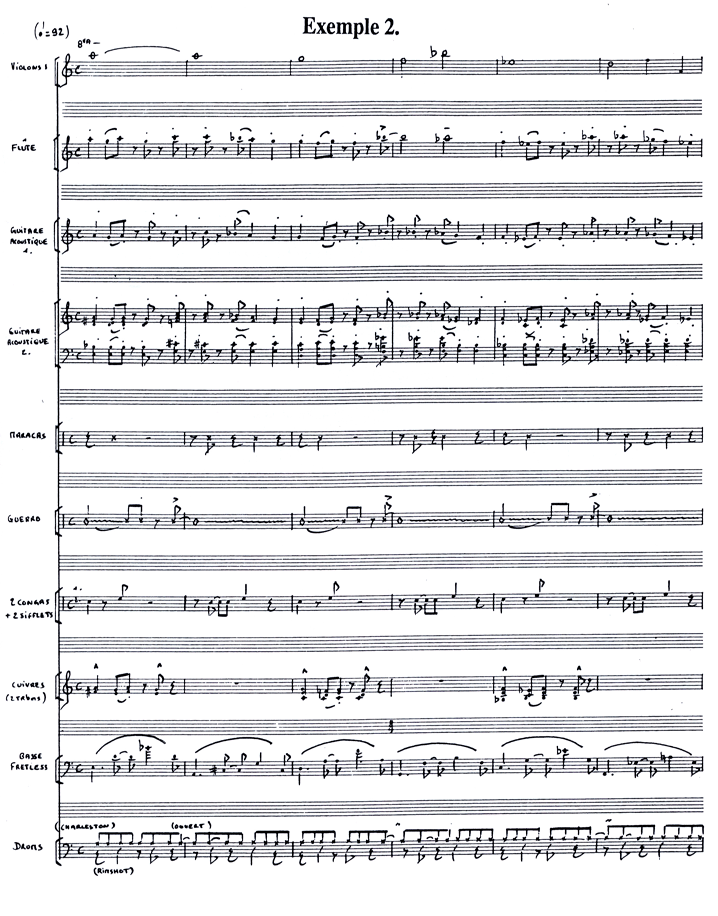1. Excerpt listening

2. Music analysis
With a symphonic color, this arranging concerns a "latin jazz" composition, similar to a bossa nova.
a. The drums
The drums are limited to a closed hi hat cymbal in regular eighth notes, punctuated by a syncopated "open position" placed on the last eighth note of bar 1 and on the 2nd eighth note of bar 2. This motive is reproduced every 2 bars.
A "rimshot" is placed on the 2nd beats, and on the 3rd offbeat (bar 1), then on the 3rd off beat and the 3rd beat of bar 2. This motive is also reproduced every 2 bars.
b. The percussions
In this style of music, the percussions are more important than traditional drums, and include :
Maracas, 1 guirro, 2 congas and 2 whistles of different pitches. The discrete maracas double the rimshot motive. The guirro plays half notes on the 1st beat of bar 1, and on the syncopated 3rd and 4th offbeats, sutained till bar 2. The congas and whistles are divided into 2 registers, low and high :
- Low register : 1st beat (bar 1), and syncopated 1st and 2nd beats in bar 2.
- High register : 2nd offbeat (bar 1) and on the 3rd beat of bar 2.
We can notice that percussions are complementary to each other and bring le-rythme and "exotic" colors to this orchestration.
c. The bass guitar
This is a fretless bass guitar chosen for its roundness and soft attack. It plays a le-rythmeic motive very common to south american music styles, representing the chords of the harmonic progression (see the "guitar" chapter below). This motive is duplicated every bar, playing the roots of the chords on each 1st beat.
d. The guitar
The classical guitar (nylon strings) provides both a "section" harmonization (each melodic note harmonized by a chord), and the main theme (on the top of the chords) reinforced by another guitar. The "jazzy" harmony uses rich chords plus their extensions.
Eg : chord 1 : E min 11 (b9)
Eg : 5th chord : A7 (#9)(b13)
Here below is the harmonic progression :
E min11(b5) / A7(#9)(b13) / D min11 / G7(#9)(b13) / C min11 / F7(#9)(b13)
The guitar le-rythme is a common syncopated latin le-rythme and the accompaniment is performed in the medium-low register.
e. The brass
The brass is limited to 2 trombones harmonized in third and reproduces the 2 top voices of the guitar chords, a little bit simplified (on the 1st beats of odd number bars).
These punctuations in parallel third are provided for a color purpose. A contrast is created by a phrasing and an accentuation each time different (on the 3rd beats), providing a relief with the guitar.
f. The flute
The C flute doubles the main melody an octave higher than the guitar, in a good register.
g. The violins
Situated in the high register, the violins provide a counter-melody to the main theme with whole tones and half notes, flying over the orchestra.